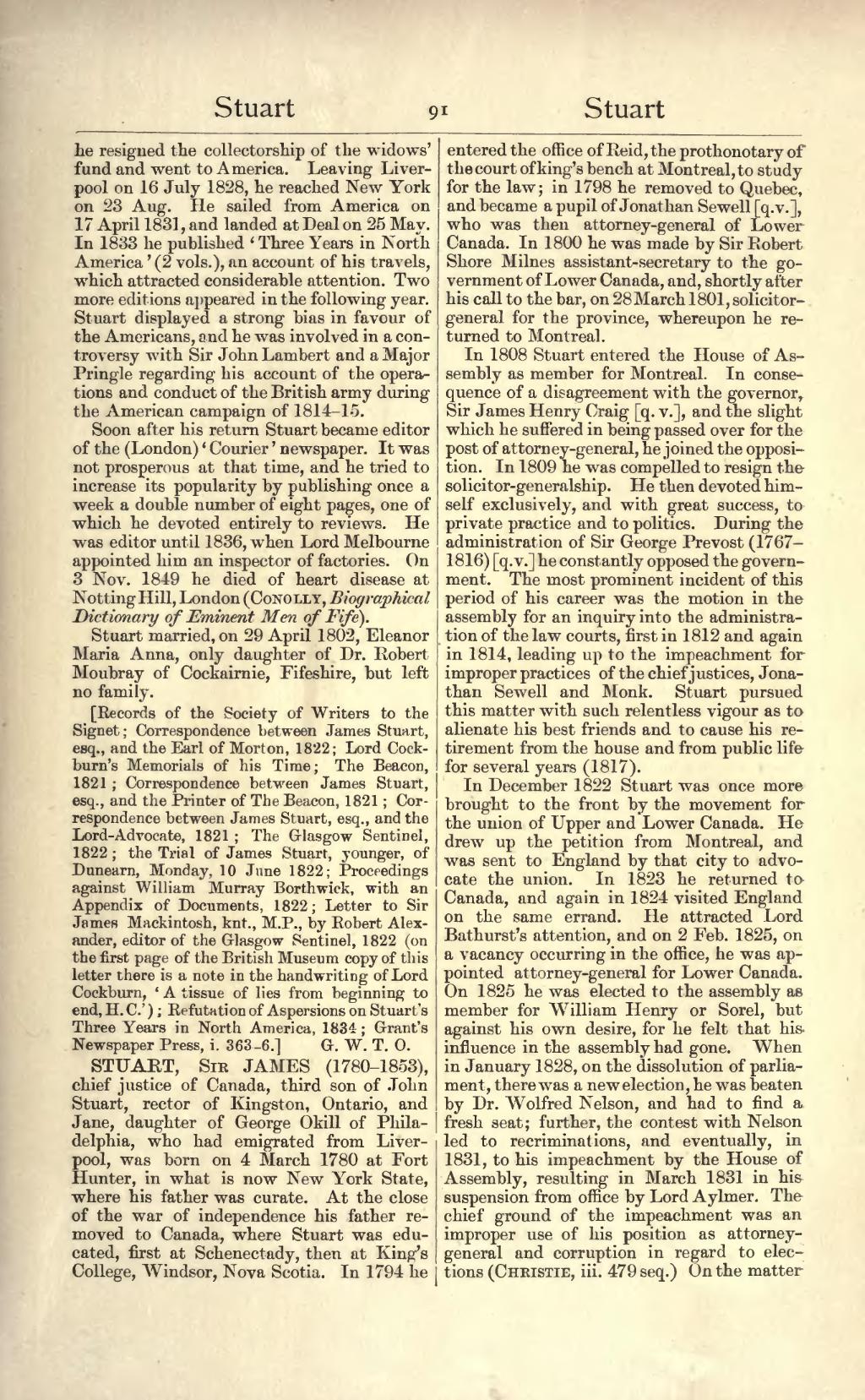he resigned the collectorship of the widows' fund and went to America. Leaving Liverpool on 16 July 1828, he reached New York on 23 Aug. He sailed from America on 17 April 1831, and landed at Deal on 25 May. In 1833 he published ‘Three Years in North America’ (2 vols.), an account of his travels, which attracted considerable attention. Two more editions appeared in the following year. Stuart displayed a strong bias in favour of the Americans, and he was involved in a controversy with Sir John Lambert and a Major Pringle regarding his account of the operations and conduct of the British army during the American campaign of 1814–15.
Soon after his return Stuart became editor of the (London) ‘Courier’ newspaper. It was not prosperous at that time, and he tried to increase its popularity by publishing once a week a double number of eight pages, one of which he devoted entirely to reviews. He was editor until 1836, when Lord Melbourne appointed him an inspector of factories. On 3 Nov. 1849 he died of heart disease at Notting Hill, London (Conolly, Biographical Dictionary of Eminent Men of Fife).
Stuart married, on 29 April 1802, Eleanor Maria Anna, only daughter of Dr. Robert Moubray of Cockairnie, Fifeshire, but left no family.
[Records of the Society of Writers to the Signet; Correspondence between James Stuart, esq., and the Earl of Morton, 1822; Lord Cockburn's Memorials of his Time; The Beacon, 1821; Correspondence between James Stuart, esq., and the Printer of The Beacon, 1821; Correspondence between James Stuart, esq., and the Lord-Advocate, 1821; The Glasgow Sentinel, 1822; the Trial of James Stuart, younger, of Dunearn, Monday, 10 June 1822; Proceedings against William Murray Borthwick, with an Appendix of Documents, 1822; Letter to Sir James Mackintosh, knt., M.P., by Robert Alexander, editor of the Glasgow Sentinel, 1822 (on the first page of the British Museum copy of this letter there is a note in the handwriting of Lord Cockburn, ‘A tissue of lies from beginning to end, H. C.’); Refutation of Aspersions on Stuart's Three Years in North America, 1834; Grant's Newspaper Press, i. 363–6.]
STUART, Sir JAMES (1780–1853), chief justice of Canada, third son of John Stuart, rector of Kingston, Ontario, and Jane, daughter of George Okill of Philadelphia, who had emigrated from Liverpool, was born on 4 March 1780 at Fort Hunter, in what is now New York State, where his father was curate. At the close of the war of independence his father removed to Canada, where Stuart was educated, first at Schenectady, then at King's College, Windsor, Nova Scotia. In 1794 he entered the office of Reid, the prothonotary of the court of king's bench at Montreal, to study for the law; in 1798 he removed to Quebec, and became a pupil of Jonathan Sewell [q. v.], who was then attorney-general of Lower Canada. In 1800 he was made by Sir Robert Shore Milnes assistant-secretary to the government of Lower Canada, and, shortly after his call to the bar, on 28 March 1801, solicitor-general for the province, whereupon he returned to Montreal.
In 1808 Stuart entered the House of Assembly as member for Montreal. In consequence of a disagreement with the governor, Sir James Henry Craig [q. v.], and the slight which he suffered in being passed over for the post of attorney-general, he joined the opposition. In 1809 he was compelled to resign the solicitor-generalship. He then devoted himself exclusively, and with great success, to private practice and to politics. During the administration of Sir George Prevost (1767–1816) [q. v.] he constantly opposed the government. The most prominent incident of this period of his career was the motion in the assembly for an inquiry into the administration of the law courts, first in 1812 and again in 1814, leading up to the impeachment for improper practices of the chief justices, Jonathan Sewell and Monk. Stuart pursued this matter with such relentless vigour as to alienate his best friends and to cause his retirement from the house and from public life for several years (1817).
In December 1822 Stuart was once more brought to the front by the movement for the union of Upper and Lower Canada. He drew up the petition from Montreal, and was sent to England by that city to advocate the union. In 1823 he returned to Canada, and again in 1824 visited England on the same errand. He attracted Lord Bathurst's attention, and on 2 Feb. 1825, on a vacancy occurring in the office, he was appointed attorney-general for Lower Canada. On 1825 he was elected to the assembly as member for William Henry or Sorel, but against his own desire, for he felt that his influence in the assembly had gone. When in January 1828, on the dissolution of parliament, there was a new election, he was beaten by Dr. Wolfred Nelson, and had to find a fresh seat; further, the contest with Nelson led to recriminations, and eventually, in 1831, to his impeachment by the House of Assembly, resulting in March 1831 in his suspension from office by Lord Aylmer. The chief ground of the impeachment was an improper use of his position as attorney-general and corruption in regard to elections (Christie, iii. 479 seq.). On the matter

